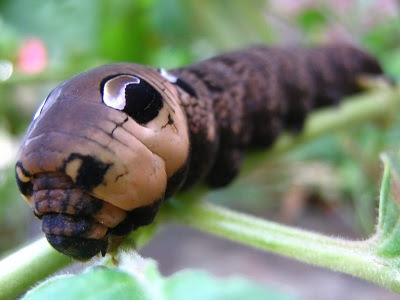 |
| The Elephant hawk moth - Deilephila elpenor |
It is arguably one of the most attractive of our native moths with olive-green patterned pink forewings and body. The hind wings are marked pink and black.
 |
| Elephant hawk moth caterpillar - Deilephila elpenor |
Like the majority of moths, it's a nocturnal species with the adults emerging in May and August. It can sometimes been seen at dusk feeding on nectar-rich blooms, and resting during the day.
The Elephant hawk-moth usually only produces one generation per year which overwinters as a pupae. The common name reflects the trunk-like front of the body, which along with the eye spot will swell up when alarmed to scare off predators. The 'trunk' is also raised up in a snake pose in order (it is believed) to protect the head of the caterpillar.
Honeysuckle is a particular favourite as well as other tubular flowered plant species such as petunias and the Fuchsia triphylla cultivars. The caterpillar feeds on Rosebay Willowherb, Great Willowherb, Bedstraw and various garden fuchsia species and hybrids.
Main image credit - nick goodrum licensed under the Creative Commons Attribution 2.0 Generic license.
For related articles click onto the following links:
THE ELEPHANT-HAWK MOTH







No comments:
Post a Comment